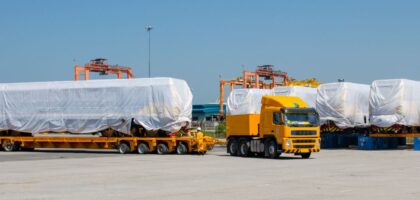Moving freight can require much planning and many choices, depending on what you’re moving, where you’re moving it, and when you need to get it there.
When it comes to logistics, there are many ways freight can be transported. Knowing the differences and benefits of each mode can help decide what works best for you.
What are the main modes of transportation in logistics?
Road Transportation
The most common and frequently used mode of transportation in logistics is road (or over-the-road). Alongside railways, trucks are the most efficient way to move goods across land. The U.S. transportation system moves an average of over 50 million tons of freight valued at more than $50 billion every day. That’s a lot of freight!
The two main types of road transportation are Less-than-Truckload (LTL) and Truckload (TL). LTL moves smaller shipments that are mainly palletized to their respective destinations along a specific route. These routes typically begin and end at specified hubs depending on the number of different shipments the truck is carrying. Although very cost-effective, LTL has a big disadvantage—the truck makes multiple stops, and a shipment could be transferred multiple times to different trucks along the route. This results in longer shipping times and the possibility of freight being lost or damaged.
TL is much faster than LTL because it does not operate on a hub and spoke model. The truck will go from origin to destination with no stops or transfers along the way. Although quicker and more efficient, the biggest disadvantage of shipping via TL is the shipper must have enough freight to transport in order to make it economical.
Overall, road transport is cost-effective and safe, but there are many external factors that play into its effectiveness, including bad weather, traffic, and road regulations.
Air Transportation
The newest mode of transportation, shipping via air is a reliable and extremely quick way to transport freight. Shipping goods domestically and internationally can be done using both commercial cargo aircraft and passenger aircraft, depending on what is being moved.
With technology continually improving and practically unlimited route possibilities, utilizing air transportation has become the fastest growing and most efficient shipping mode. Many companies turn to air shipping to move their high-value freight and goods, especially when they’re in a time crunch.
Although there are many benefits to air transportation, the biggest drawback is the cost. Air transport is by far the most expensive way to ship freight out of all modes. In addition, the level of emissions produced by air transport is also the highest of any mode.
Ocean Transportation
Also known as “maritime transportation,” moving goods by water is the oldest mode of transport, and to this day, remains pivotal to modern day global trade. To put it in perspective, 90% of all international trade is done through ocean transportation, making it the primary way to move goods globally. Compared to air, ocean is much more cost-effective, but it is also the slowest option when moving freight. This mode of transportation works best for shippers who are moving large volumes of goods overseas that need to travel a distance longer than 400 km. This mode also works great for oversized, hazardous, and odd-shaped freight.
As mentioned above, the biggest disadvantage to ocean transportation is the speed at which the freight moves. However, it is the most efficient for the amount of cargo it is capable of handling. Additionally, the cargo emissions produced by one ship are equivalent to the emissions produced by 50 million cars—yikes!
Rail Transportation
Probably the least discussed and most underrated mode of transportation is rail shipping. First invented in the early 19th century, rail transport quickly became vital for the expansion of the western world and has been a crucial part of the logistics industry for the last two centuries.
Rail transportation plays a huge role in intermodal transportation (don’t worry, we’ll review that in the next section). This mode is best used for pre-planned long hauls and large, heavy payloads (bulk cargo) traveling across land. Moving goods by rail is often much cheaper, more efficient, and less environmentally damaging then sending goods by road. Almost $500 billion of freight is transported by rail every year in the U.S. with many of the trips being 1,500 miles or more.
Although rail transportation is not affected by traffic, points of diversion, and switch offs between modes, it is confined to a more limited infrastructure than road transport.
Intermodal and Multimodal Transportation
Intermodal and multimodal transportation is used quite often in logistics and is when a shipment is completed using multiple modes of transportation. Intermodal transportation solves the problems of long and complicated routes by combining road, rail, ocean, or air to get the shipment to its destination successfully. In recent years, intermodal has experienced a high uptick, especially with the rising shipping rates and shortage of truck drivers.
The only difference between intermodal and multimodal transportation is intermodal is handled under a single bill of lading, while multimodal goes with separate bills of lading from all carriers involved with moving the shipment.
Resources:
- The 6 Modes of Transportation (Mihlfeld & Associates)
- Different Modes of Transportation: Transport & Logistics (GoShip)
- Modes of Transportation in the Global Supply Chain (Blume Global)



